Changsheng Xu
Look Before You Leap: A GUI-Critic-R1 Model for Pre-Operative Error Diagnosis in GUI Automation
Jun 05, 2025Abstract:In recent years, Multimodal Large Language Models (MLLMs) have been extensively utilized for multimodal reasoning tasks, including Graphical User Interface (GUI) automation. Unlike general offline multimodal tasks, GUI automation is executed in online interactive environments, necessitating step-by-step decision-making based on real-time status of the environment. This task has a lower tolerance for decision-making errors at each step, as any mistakes may cumulatively disrupt the process and potentially lead to irreversible outcomes like deletions or payments. To address these issues, we introduce a pre-operative critic mechanism that provides effective feedback prior to the actual execution, by reasoning about the potential outcome and correctness of actions. Specifically, we propose a Suggestion-aware Gradient Relative Policy Optimization (S-GRPO) strategy to construct our pre-operative critic model GUI-Critic-R1, incorporating a novel suggestion reward to enhance the reliability of the model's feedback. Furthermore, we develop a reasoning-bootstrapping based data collection pipeline to create a GUI-Critic-Train and a GUI-Critic-Test, filling existing gaps in GUI critic data. Static experiments on the GUI-Critic-Test across both mobile and web domains reveal that our GUI-Critic-R1 offers significant advantages in critic accuracy compared to current MLLMs. Dynamic evaluation on GUI automation benchmark further highlights the effectiveness and superiority of our model, as evidenced by improved success rates and operational efficiency.
Locality Preserving Markovian Transition for Instance Retrieval
Jun 05, 2025Abstract:Diffusion-based re-ranking methods are effective in modeling the data manifolds through similarity propagation in affinity graphs. However, positive signals tend to diminish over several steps away from the source, reducing discriminative power beyond local regions. To address this issue, we introduce the Locality Preserving Markovian Transition (LPMT) framework, which employs a long-term thermodynamic transition process with multiple states for accurate manifold distance measurement. The proposed LPMT first integrates diffusion processes across separate graphs using Bidirectional Collaborative Diffusion (BCD) to establish strong similarity relationships. Afterwards, Locality State Embedding (LSE) encodes each instance into a distribution for enhanced local consistency. These distributions are interconnected via the Thermodynamic Markovian Transition (TMT) process, enabling efficient global retrieval while maintaining local effectiveness. Experimental results across diverse tasks confirm the effectiveness of LPMT for instance retrieval.
Harmony: A Unified Framework for Modality Incremental Learning
Apr 17, 2025Abstract:Incremental learning aims to enable models to continuously acquire knowledge from evolving data streams while preserving previously learned capabilities. While current research predominantly focuses on unimodal incremental learning and multimodal incremental learning where the modalities are consistent, real-world scenarios often present data from entirely new modalities, posing additional challenges. This paper investigates the feasibility of developing a unified model capable of incremental learning across continuously evolving modal sequences. To this end, we introduce a novel paradigm called Modality Incremental Learning (MIL), where each learning stage involves data from distinct modalities. To address this task, we propose a novel framework named Harmony, designed to achieve modal alignment and knowledge retention, enabling the model to reduce the modal discrepancy and learn from a sequence of distinct modalities, ultimately completing tasks across multiple modalities within a unified framework. Our approach introduces the adaptive compatible feature modulation and cumulative modal bridging. Through constructing historical modal features and performing modal knowledge accumulation and alignment, the proposed components collaboratively bridge modal differences and maintain knowledge retention, even with solely unimodal data available at each learning phase.These components work in concert to establish effective modality connections and maintain knowledge retention, even when only unimodal data is available at each learning stage. Extensive experiments on the MIL task demonstrate that our proposed method significantly outperforms existing incremental learning methods, validating its effectiveness in MIL scenarios.
A Survey on Cross-Modal Interaction Between Music and Multimodal Data
Apr 17, 2025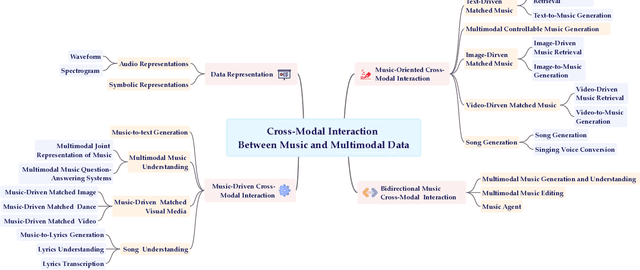
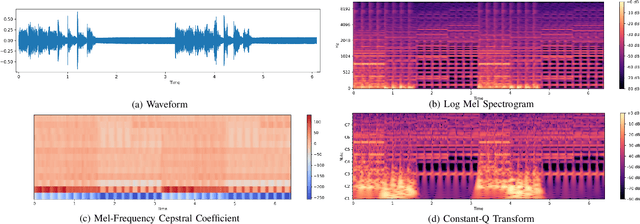
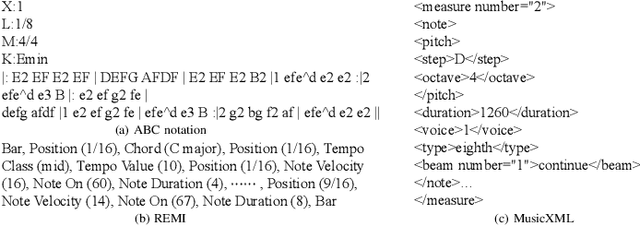
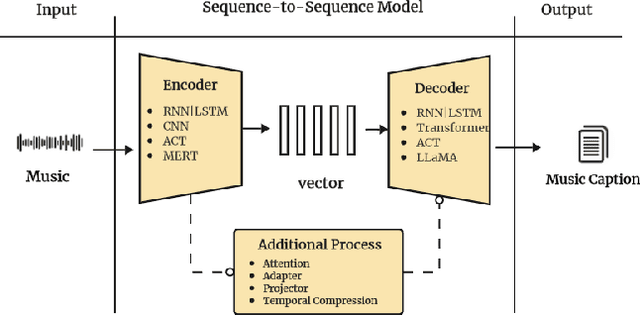
Abstract:Multimodal learning has driven innovation across various industries, particularly in the field of music. By enabling more intuitive interaction experiences and enhancing immersion, it not only lowers the entry barriers to the music but also increases its overall appeal. This survey aims to provide a comprehensive review of multimodal tasks related to music, outlining how music contributes to multimodal learning and offering insights for researchers seeking to expand the boundaries of computational music. Unlike text and images, which are often semantically or visually intuitive, music primarily interacts with humans through auditory perception, making its data representation inherently less intuitive. Therefore, this paper first introduces the representations of music and provides an overview of music datasets. Subsequently, we categorize cross-modal interactions between music and multimodal data into three types: music-driven cross-modal interactions, music-oriented cross-modal interactions, and bidirectional music cross-modal interactions. For each category, we systematically trace the development of relevant sub-tasks, analyze existing limitations, and discuss emerging trends. Furthermore, we provide a comprehensive summary of datasets and evaluation metrics used in multimodal tasks related to music, offering benchmark references for future research. Finally, we discuss the current challenges in cross-modal interactions involving music and propose potential directions for future research.
Short-video Propagation Influence Rating: A New Real-world Dataset and A New Large Graph Model
Mar 31, 2025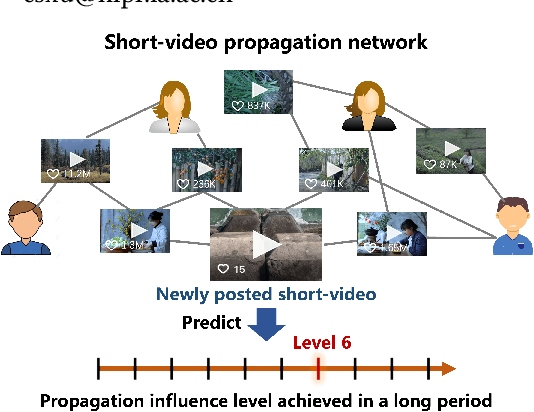

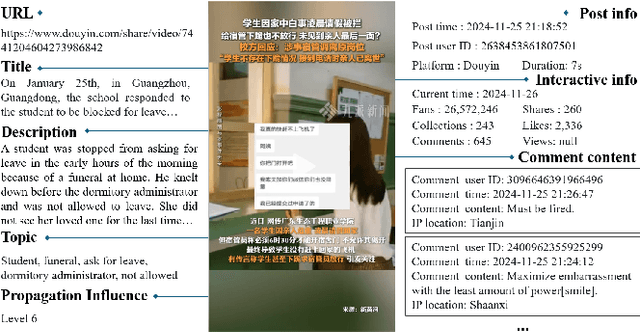
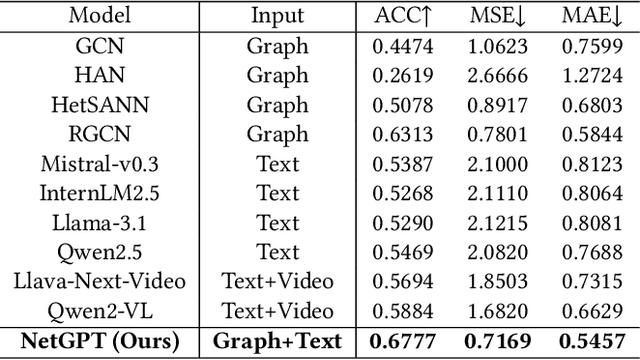
Abstract:Short-video platforms have gained immense popularity, captivating the interest of millions, if not billions, of users globally. Recently, researchers have highlighted the significance of analyzing the propagation of short-videos, which typically involves discovering commercial values, public opinions, user behaviors, etc. This paper proposes a new Short-video Propagation Influence Rating (SPIR) task and aims to promote SPIR from both the dataset and method perspectives. First, we propose a new Cross-platform Short-Video (XS-Video) dataset, which aims to provide a large-scale and real-world short-video propagation network across various platforms to facilitate the research on short-video propagation. Our XS-Video dataset includes 117,720 videos, 381,926 samples, and 535 topics across 5 biggest Chinese platforms, annotated with the propagation influence from level 0 to 9. To the best of our knowledge, this is the first large-scale short-video dataset that contains cross-platform data or provides all of the views, likes, shares, collects, fans, comments, and comment content. Second, we propose a Large Graph Model (LGM) named NetGPT, based on a novel three-stage training mechanism, to bridge heterogeneous graph-structured data with the powerful reasoning ability and knowledge of Large Language Models (LLMs). Our NetGPT can comprehend and analyze the short-video propagation graph, enabling it to predict the long-term propagation influence of short-videos. Comprehensive experimental results evaluated by both classification and regression metrics on our XS-Video dataset indicate the superiority of our method for SPIR.
Language Guided Concept Bottleneck Models for Interpretable Continual Learning
Mar 30, 2025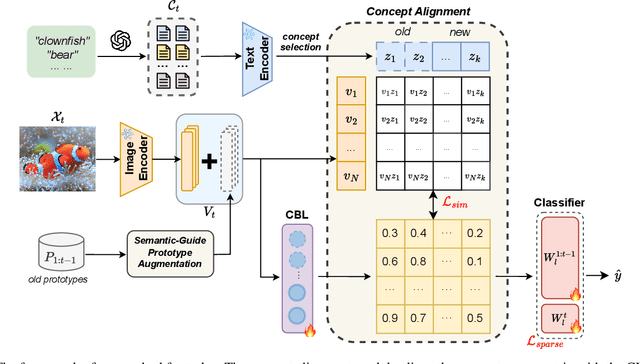


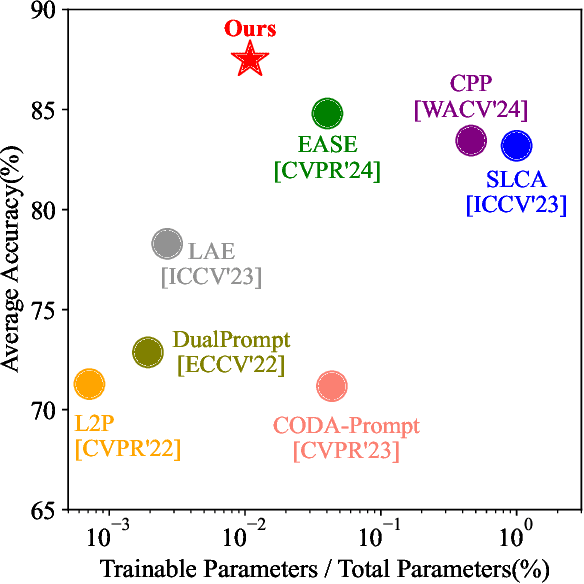
Abstract:Continual learning (CL) aims to enable learning systems to acquire new knowledge constantly without forgetting previously learned information. CL faces the challenge of mitigating catastrophic forgetting while maintaining interpretability across tasks. Most existing CL methods focus primarily on preserving learned knowledge to improve model performance. However, as new information is introduced, the interpretability of the learning process becomes crucial for understanding the evolving decision-making process, yet it is rarely explored. In this paper, we introduce a novel framework that integrates language-guided Concept Bottleneck Models (CBMs) to address both challenges. Our approach leverages the Concept Bottleneck Layer, aligning semantic consistency with CLIP models to learn human-understandable concepts that can generalize across tasks. By focusing on interpretable concepts, our method not only enhances the models ability to retain knowledge over time but also provides transparent decision-making insights. We demonstrate the effectiveness of our approach by achieving superior performance on several datasets, outperforming state-of-the-art methods with an improvement of up to 3.06% in final average accuracy on ImageNet-subset. Additionally, we offer concept visualizations for model predictions, further advancing the understanding of interpretable continual learning.
Efficient Multi-Instance Generation with Janus-Pro-Dirven Prompt Parsing
Mar 27, 2025Abstract:Recent advances in text-guided diffusion models have revolutionized conditional image generation, yet they struggle to synthesize complex scenes with multiple objects due to imprecise spatial grounding and limited scalability. We address these challenges through two key modules: 1) Janus-Pro-driven Prompt Parsing, a prompt-layout parsing module that bridges text understanding and layout generation via a compact 1B-parameter architecture, and 2) MIGLoRA, a parameter-efficient plug-in integrating Low-Rank Adaptation (LoRA) into UNet (SD1.5) and DiT (SD3) backbones. MIGLoRA is capable of preserving the base model's parameters and ensuring plug-and-play adaptability, minimizing architectural intrusion while enabling efficient fine-tuning. To support a comprehensive evaluation, we create DescripBox and DescripBox-1024, benchmarks that span diverse scenes and resolutions. The proposed method achieves state-of-the-art performance on COCO and LVIS benchmarks while maintaining parameter efficiency, demonstrating superior layout fidelity and scalability for open-world synthesis.
Unifying Perplexing Behaviors in Modified BP Attributions through Alignment Perspective
Mar 14, 2025Abstract:Attributions aim to identify input pixels that are relevant to the decision-making process. A popular approach involves using modified backpropagation (BP) rules to reverse decisions, which improves interpretability compared to the original gradients. However, these methods lack a solid theoretical foundation and exhibit perplexing behaviors, such as reduced sensitivity to parameter randomization, raising concerns about their reliability and highlighting the need for theoretical justification. In this work, we present a unified theoretical framework for methods like GBP, RectGrad, LRP, and DTD, demonstrating that they achieve input alignment by combining the weights of activated neurons. This alignment improves the visualization quality and reduces sensitivity to weight randomization. Our contributions include: (1) Providing a unified explanation for multiple behaviors, rather than focusing on just one. (2) Accurately predicting novel behaviors. (3) Offering insights into decision-making processes, including layer-wise information changes and the relationship between attributions and model decisions.
PC-Agent: A Hierarchical Multi-Agent Collaboration Framework for Complex Task Automation on PC
Feb 21, 2025Abstract:In the field of MLLM-based GUI agents, compared to smartphones, the PC scenario not only features a more complex interactive environment, but also involves more intricate intra- and inter-app workflows. To address these issues, we propose a hierarchical agent framework named PC-Agent. Specifically, from the perception perspective, we devise an Active Perception Module (APM) to overcome the inadequate abilities of current MLLMs in perceiving screenshot content. From the decision-making perspective, to handle complex user instructions and interdependent subtasks more effectively, we propose a hierarchical multi-agent collaboration architecture that decomposes decision-making processes into Instruction-Subtask-Action levels. Within this architecture, three agents (i.e., Manager, Progress and Decision) are set up for instruction decomposition, progress tracking and step-by-step decision-making respectively. Additionally, a Reflection agent is adopted to enable timely bottom-up error feedback and adjustment. We also introduce a new benchmark PC-Eval with 25 real-world complex instructions. Empirical results on PC-Eval show that our PC-Agent achieves a 32% absolute improvement of task success rate over previous state-of-the-art methods. The code is available at https://github.com/X-PLUG/MobileAgent/tree/main/PC-Agent.
Bringing Characters to New Stories: Training-Free Theme-Specific Image Generation via Dynamic Visual Prompting
Jan 26, 2025



Abstract:The stories and characters that captivate us as we grow up shape unique fantasy worlds, with images serving as the primary medium for visually experiencing these realms. Personalizing generative models through fine-tuning with theme-specific data has become a prevalent approach in text-to-image generation. However, unlike object customization, which focuses on learning specific objects, theme-specific generation encompasses diverse elements such as characters, scenes, and objects. Such diversity also introduces a key challenge: how to adaptively generate multi-character, multi-concept, and continuous theme-specific images (TSI). Moreover, fine-tuning approaches often come with significant computational overhead, time costs, and risks of overfitting. This paper explores a fundamental question: Can image generation models directly leverage images as contextual input, similarly to how large language models use text as context? To address this, we present T-Prompter, a novel training-free TSI method for generation. T-Prompter introduces visual prompting, a mechanism that integrates reference images into generative models, allowing users to seamlessly specify the target theme without requiring additional training. To further enhance this process, we propose a Dynamic Visual Prompting (DVP) mechanism, which iteratively optimizes visual prompts to improve the accuracy and quality of generated images. Our approach enables diverse applications, including consistent story generation, character design, realistic character generation, and style-guided image generation. Comparative evaluations against state-of-the-art personalization methods demonstrate that T-Prompter achieves significantly better results and excels in maintaining character identity preserving, style consistency and text alignment, offering a robust and flexible solution for theme-specific image generation.
 Add to Chrome
Add to Chrome Add to Firefox
Add to Firefox Add to Edge
Add to Edge